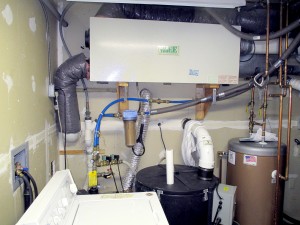The Need for Mechanical Ventilation in Energy Efficient Homes

A bathroom fan helps with indoor air quality.
By Michael Goetinck
If you’ve ever been in a room where the air felt “too close” or you’ve ever experienced the need to step outside for a breath of fresh air you have an intuitive understanding of the importance of indoor air quality.
Indoor air quality is affected by many things. Building assemblies, components, items in the home, occupants and their behaviors, and the quality of the air outside the home all play a role. Indoor air quality is a function of air infiltration and ventilation. Sometimes these air exchanges happen intentionally and sometimes not. In an efficient home ventilation has to be intentional since there has been a great deal of attention paid to reducing air infiltration. Therein lies the apparent irony: you’ve spent a great deal of resources (time, money, and thought) on reducing the number of air changes per hour and now you have to add some back into the mix. The difference between unintentional and intentional ventilation is that the first method leaves it to chance and makes the building less efficient, whereas the second is by design and makes the building more efficient.
One may question the need for mechanical ventilation since it’s hard to know how necessary it really is without actually testing the air quality. A friend of mine used to test indoor air quality for large commercial buildings and he told me that you can’t just test air to see if it’s healthful or not. You have to test for specific things. Since there are so many substances that can adversely affect the quality of the air; testing for all of them, and then monitoring on an ongoing basis isn’t something that most homeowners are going to undertake. In the world of sports it has been said that the best defense is a good offense and the same is true in the world of residential air quality: mechanical ventilation is part of a good offense. Continually exchanging indoor and outdoor air prevents moisture and pollutants from concentrating in the home thereby reducing the risk of creating an environment that is detrimental to the building and its occupants.

A whole house Energy Recovery Ventilator (ERV).
I’ve written about moisture mitigation in previous articles and the need to manage it at the source. Cooking and cleaning (house, and personal) are two significant sources of moisture resulting from day-to-day living in a home and it’s best to get the moisture generated by these activities out of the house as quickly as possible. This can be accomplished with exhaust fans or heat recovery ventilators (HRVs) with exhaust boosts. There are some whole-house systems that can eliminate the need for site specific exhaust.
Most non-moisture related contaminants from people, pets, and items normally found in people’s homes can be prevented from reaching harmful concentrations by installing a HRV in a heating climate or an Energy Recovery Ventilator (ERV) in a cooling climate to exchange indoor and outdoor air. The amount of air being exchanged can be set on most units and it’s a good idea to change the settings as the use of the space changes. For instance, the setting should be adjusted if the number of people in the home changes.
If you are building a new home or doing a “deep-energy retro-fit,” mechanical ventilation needs to be part of the plan. If you want to make an existing home more efficient, I recommend using a blower door to calculate the number of air changes per hour the building currently experiences and use that information to determine at what point in the process you need to install mechanical ventilation.
Michael Goetinck is the owner of Snowdog Construction, Ltd, in Norwich, VT. This series will continue in Green Energy Times, where the author will cover other topics that can help achieve the deep energy measures which help buildings’ energy performance, and so can benefit us all.








Leave a Reply